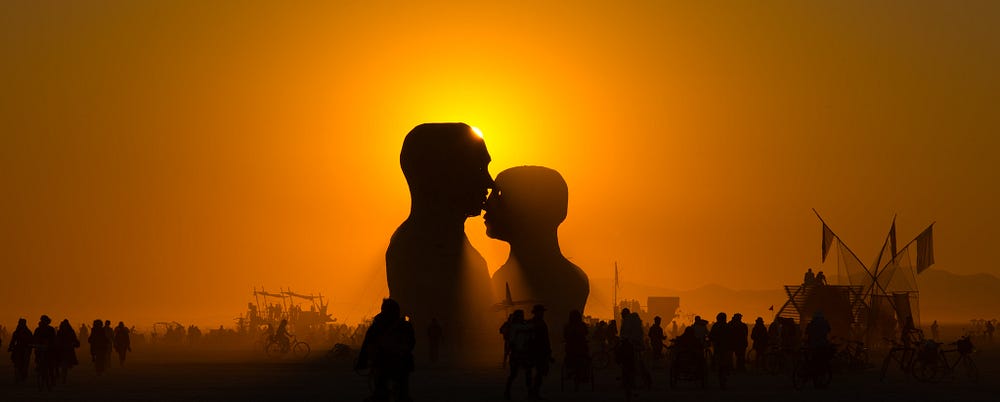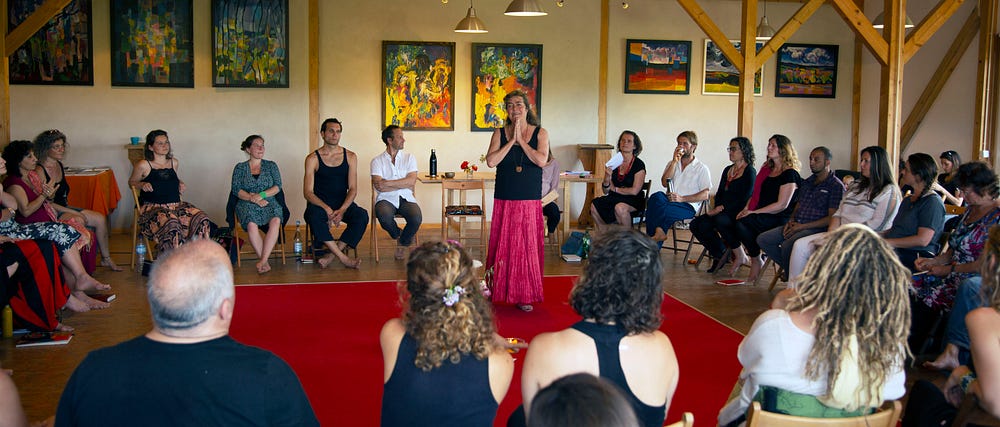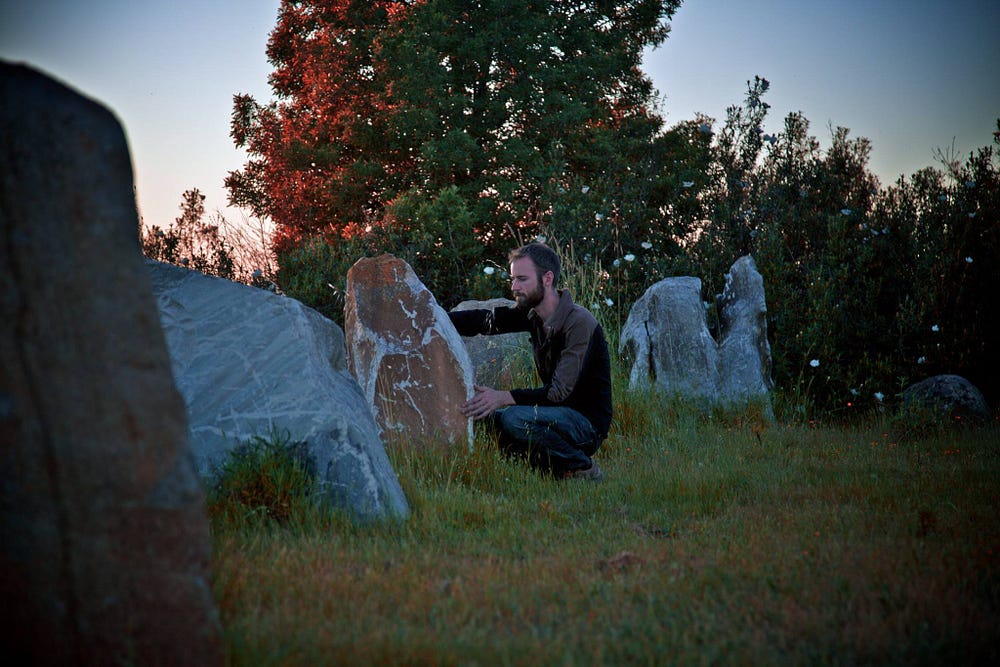“Oh, home, let me come home
Home is whenever I’m with you.”
~Edward Sharpe and the Magnetic Zeroes
As I pull my car up the opening gates of Burning Man, I am greeted by a naked man in a cowboy hat. He waves me to stop the car, then peers into the driver’s side window at my friend and I.
“Howdy! Any first timers in here?” he asks.
I hesitate, wondering the consequence of a truthful response.
“Well… we’re both new.” I say uncertainly.
“Come on out then!” the man announces and backs away from the door. My friend steps out of the vehicle into the searing heat of the Black Rock Desert, while at least six other rows of cars and greeters buzz around us.
I can’t tell if naked cowboy man is deeply tanned, or simply caked in dust. He wears the characteristic goggles and mask around his neck, as if he’s wandered out of an apocalyptic porno shoot. He guides us toward a large metal bell, suspended by a welded triangle about 5 feet above the ground.
“First, you need to be baptized by the dust. Git down there and roll on the ground.”
My friend and I look at each other. He gives a quick shrug and we remove our shirts. I hit the dust and sweep my arms overhead like a snow angel. The desert is softer than I anticipated and quickly coats my torso and legs. I hop up and nod to Cowboy man. He hands me a heavy metal club.
“Now hit that bell like you ‘effing mean it!” he crows.
I swing with both hands and am rewarded with an ear shattering clang that is quickly swallowed by the rest of the din.
Cowboy man, still naked, gathers me into his firm embrace. When he is done, he grips me by the shoulders, leans back, and says:
“Welcome home.”
___
At the time, I could not have known the prescience of this opening ritual, offered to all first-timers of Burning Man. Like many, I came to escape the insanity and the banality of the “default world” — the term given to the culture outside the gates of Black Rock City. Here in this experimental utopia, I found the bizarre and the beautiful, the sacred and the profane, and the possibility that humans might not be so bad, after all.
I returned for a total of six years (2009–2014). I was given a playa name (Vision Weaver). I served numerous times as a Temple Guardian (which inspired two short films Dear Temple and Dear Guardians). I avoided the inevitable seduction to be cynical (“It was so better last year!”) to emerge into the higher achievement of “post-jaded.” And come every August, I still appreciate the longing that arises when I spot a vehicle loaded with costumes and bicycles, headed for the mayhem and mystery that await them in the desert.
It’s common to hear Burning Man novices speak of the idyllic week as the antidote to the way it is. “I wish life were like this all the time!” they proclaim, even as they stagger out of the desert at the end of the week, depleted by sun, sleep deprivation, and dubstep.
Whereas many have written over the years about “what is Burning Man?” — I’ve continued to ponder a different question: why is there Burning Man? To whom does Burning Man make sense? And further, what had to happen to a people whereby a place that literally doesn’t exist, arises and is gone in 7 days, is affectionally known as “home?”

Photo: John Stephen Chandler
“I’ll follow you into the park
Through the jungle, through the dark
Girl, I never loved one like you.”
One of the unofficial anthem’s for Burners is the song “Home” by Edward Sharpe and the Magnetic Zeroes, inspired by a sing-along Youtube montage that went viral back in 2011. Many who attend Burning Man feel a recognition “finally here are my people.” The misfits. The crazies. The non-conformists. The creatives. Finally, I am home.
Alex Ebert, (real name of the frontman of the Edward Sharpe), met girlfriend Jade Castrinos at a coffee shop in LA which months later led to recording their breakout album and the iconic song, built on the real chemistry between them.
The endearing nature of the track speaks of the romantic ideal, of finding that mythic ONE where you finally feel a sense of being at “home” for the first time.
Ask a crowd of people who grew up in the dominant culture of North America about “the One” and most will answer easily, offering a generally unspoken though clear portrait of a collective understanding.
The One is:
- the person you’re supposed to find and get married and have babies with and grow old and die together (thanks Up for perfectly capturing this sentiment)
- that person you’re supposed to find that completes you (thanks Jerry Maguire)
- the person that will have attraction only for you and no one else (thanks every pop love song, ever)
** Even for those who don’t conform to heteronormative narratives, I suspect these layers of conditioning continue to have their influence in different ways.
I lived the story of the One.
In 2003, I met the woman who I would eventually marry. We shared a real friendship, many of the same interests, and a healthy sexual connection. In 2006, I proposed on a beach in Thailand and in the early summer of 2007 we were married. We moved from our city apartment to a larger condo in the suburbs outside Vancouver, and then a few years later, bought a home with the support of her mother who moved into the basement suite. We had crafted the perfect vision of home together.
At the same time, cracks had been appearing in the foundation. Though we had numerous friends, we didn’t share much about the growing challenges within the relationship (as is the norm for many). We had significant difficulties conceiving a child. A lagging erotic attraction between the both of us provoked various attempts to “spice things up”, along with my clumsy attempts to invite a friend into a threesome. Eventually, with the advent of making contact with other sub-cultures (such as Burning Man and the local kink scene) I realized I had a desire to explore other models of relating, in particular which involved opening our “default” monogamous relationship.
A year later my wife fell in love with another man and wished to commit to a monogamous partnership with him. Our marriage dissolved and it was clear that I would move out.
I vividly recall packing my things into my hatchback on the final afternoon, my entire life now packed inside a single vehicle. As I drove away from the woman I had thought for 10 years was my “One”, I also drove away from my home — or at least the only conception I had for home.
As it is for so many in this culture, these two things are inseparable.
____
The following years I fled into the polyamorous world. I began dating an artist and DJ who had a few years of poly practice ahead of me. I felt that finally I could throw off the bonds of monogamy and liberate my authentic erotic being. No longer would I constrict my desire towards other women out of needing to be “a good boy.” I had found the path of enlightenment and it felt like freedom.
Until I soon realized all of the old patterns in myself and my lovers continued to return. Only this time, it was multiplied many times over. (The term ‘poly-agony’ hits the mark entirely). The solution I thought I’d found turned out to be a reaction instead of a true alternative.
 Tamera co-founder Sabine Lichtenfels
Tamera co-founder Sabine Lichtenfels
In 2015, I arrived at the “free love” community of Tamera in Portugal, on the heels of an invitation to produce a short film about their 40 years of research into eros and building communities of trust. I was joined by filmmaker and co-director John Wolfstone.
We spent 10 days immersed in their Global Love School, a convergence of artists and activists from regions around the world — Israel/Palestine, Colombia, Kenya, Brazil, Italy, Germany, the UK, the United States and Canada.
This experience changed me utterly.
It was here that I witnessed their practice of The Forum — a strange and wonderful process of inviting individuals into a shared space to be facilitated in a “performance” of their inner world. This raw and powerful ritual enables the ability to dis-identify with their personal issue and see it as a collective issue within a wider cultural context.
After watching the second performance — heart beating fiercely, I felt the call to step into the space.
With Love School and Tamera co-founder Sabine Lichtenfels at the helm, I found an intuitive sense of trust that I could navigate into places of my recent history that I hadn’t been able to touch on my own. I was guided to share the story of my marriage ending, and with the soft supportive gaze of the circle, I dove into the layers of repressed anger that (surprise) masked a deep well of grief that I had yet to allow myself to feel.
Ragged rage finally escaped my core.
The end of the 15 minute performance culminated in an embrace with Sabine, who in that moment was the archetype of the loving Grandmother, while the community spontaneously hummed a rendition of “Amazing Grace.” It was a moment of profound healing that I will never forget.
 At the stone circle of Tamera.
At the stone circle of Tamera.
I would return to Tamera for three additional visits, and our duo would become a trio with filmmaker Julia Maryanska. Each time I deepened in their core frames of research into modelling a true culture of peace.
I learned their practice of “free love” means “love free of fear.” A commitment to creating a culture where lovers do not have to lie to each other about their inner world — their longings, their judgements, and their attractions to others. From this revealing of what is true for each person, then the form of every relationship can be what it actually wishes to be — whether monogamous, polyamorous, celibate, companionship, and every other variation.
I learned that “jealously does not belong to love.” Meaning: jealousy is better understood as a mix of other emotions, often from a comparison to others and fear of losing the lover/partner. Solidarity within the genders is necessary to connect with the same heart of “the other” and realize they share a kinship that can be strengthened through sharing lovers (if that is what is true), rather than a competition.
And I learned that seeking home in another is entirely understandable — when you have never lived in broader connection with other human beings, where all are invested in each other to flourish in their wholeness and brilliance.
With this I’m speaking about my emerging understanding of village.
_____
I return to my initial question earlier: Why is there Burning Man?
I remember hearing the word “utopia” many times throughout my years in attendance. The term ‘utopia’ is widely translated as meaning ‘the perfect place’ or ‘the place we’re trying to get to if we all stopped fighting and loved each other.’
But the literal translation means something closer to ‘no place.’
A place that does not actually exist.
A place that many call home, though only lasts 7 days before it’s gone.
Another question: why is Burning Man predominantly white? (ie. populated by those who no longer have connection to their own ancestral culture and homelands). Is it because “black folks don’t like to camp as much as white folks?” as founder Larry Harvey has said?
Consider: to be indigenous means to belong to a place. Not just a broad claim to be from planet Earth, but a specific place. It does not mean “something white people will never be” as it might seem to those looking in as outsiders toward an intact culture — with their songs, ceremonies, and regalia.
Indigenous could mean: “every people come from a specific place, and the consequence of colonization and displacement has been generations of forgetting of how to be from somewhere. Instead, all they have left is the longing to belong. And therefore, finding a sense of home in a nowhere place is suddenly understandable.”
Burning Man is the perfect place for the children of nowhere.
This is not so much a critique but an invitation to feel the deeper longing that yearns to be planted, again. These could be the seeds of village offering tentative tendrils back into the soil — if we are willing to recognize how to water them.